Safety in Custody Statistics, England and Wales: Deaths in Prison Custody to September 2023 Assaults and Self-harm to June 2023
Published 26 October 2023
Applies to England and Wales
| Number of deaths decreased from the previous 12-month period | In the 12 months to September 2023, there were 304 deaths in prison custody, a decrease of 1% from 307 deaths in the previous 12 months. Of these, 92 deaths were self-inflicted, a 24% increase from the 74 self-inflicted deaths in the previous 12 months. In the most recent quarter there were 75 deaths, a 23% increase from 61 deaths in the previous quarter. |
| The rate of self-harm incidents increased in both male and female establishments from the previous 12-month period | There were 64,348 self-harm incidents in the 12 months to June 2023, up 21% from the previous 12 months, comprising of an 8% increase in male establishments and a considerable 65% increase in female establishments. Over the same period, the rate of self-harm incidents per 1,000 prisoners, which takes account of the increase in the prison population between this and the previous year, increased 3% in male establishments and increased 63% in female establishments. In the most recent quarter, there were 17,729 self-harm incidents, up 7% on the previous quarter, comprising a 16% increase in male establishments and an 11% decrease in female establishments. |
| The number of individuals who self-harmed increased | There were 11,760 individuals who self-harmed in the 12 months to June 2023, up 7% from the previous 12 months. The number of self-harm incidents per individual increased from 4.8 in the 12 months to June 2022 to 5.5 in the 12 months to June 2023. |
| The rate of assaults increased from the previous 12-month period | In the 12 months to June 2023, the rate of assaults was 285 assaults per 1,000 prisoners (23,557 assaults), up 9% from the 12 months to June 2022. In the most recent quarter, assaults were up 9% to 6,560 incidents and the assault rate was up 6% to 78 assaults per 1,000 prisoners. |
| The rate of assaults on staff increased from the previous 12-month period | In the 12 months to June 2023, the rate of assaults on staff was 96 assaults per 1,000 prisoners (7,908 assaults on staff), up 1% from the 12 months to June 2022. In the latest quarter the number of assaults on staff increased by 13% to 2,222 incidents. |
| The number of serious assaults increased 11 % of all assaults were serious |
In the 12 months to June 2023, the rate of serious assaults was 33 serious assaults per 1,000 prisoners (2,704 serious assaults), up 16% from the 12 months to June 2022. The rate of serious prisoner-on-prisoner assaults increased 23% to 24 per 1,000 prisoners (1,986 incidents), and the rate of serious assaults on staff remained broadly stable at 9 per 1,000 prisoners (748 incidents) in the 12 months to June 2023. |
If you are a journalist covering a suicide-related issue, please follow the Samaritans’ Media Guidelines for Reporting Suicide because of the potentially damaging consequences of irresponsible reporting.
If you are struggling to cope, please call Samaritans for free on 116 123 (UK and the Republic of Ireland) or contact other sources of support, such as those listed on the NHS help for suicidal thoughts webpage. Support is available around the clock, every day of the year, providing a safe place for you, whoever you are and however you are feeling.
Statistician’s comment
In the 12 months to September 2023, we have seen a slight decrease in the number of deaths (1% decrease). In the 12 months to June 2023, we have seen increases in the number of assault incidents (15% increase) and self-harm incidents (21% increase) compared with the previous year, with self-harm now higher than pre-pandemic levels. Incidents of self-harm and assaults have increased in both male and female establishments over the past 12 months, with self-harm in female establishments reaching its highest level in the time series[footnote 1]. Comparisons of these statistics with earlier periods will reflect the impact of Covid-19 restrictions as well as underlying trends.
The number of deaths has decreased to 304 in the 12 months to September 2023. There were 75 deaths in the latest quarter, up from 61 the previous quarter. There were 92 self-inflicted deaths in the latest year, an increase from 74 in the previous year.
There was a 16% increase in the rate[footnote 2] of self-harm incidents per 1,000 prisoners in the 12 months to June 2023. However, there continue to be notable differences in self-harm trends by gender, with the differences increasing substantially in the latest 12 months. The rate in female establishments has increased considerably by 63% to a new peak (6,213 per 1,000 prisoners), compared to a much smaller increase of 3% in male establishments (555 per 1,000 prisoners). The rate is now more than eleven times higher in female establishments. This was driven by a substantial increase in the average number of incidents among those who self-harmed in female establishments, from 11.5 to 17.9, an acceleration in the increasing trend in average number of incidents seen for the last six years. By comparison, the average number of incidents among those who self-harmed in male establishments stayed at 4.1.
The rate of assault incidents per 1,000 prisoners increased 9% in the 12 months to June 2023, and the rate of serious assaults increased 16% over the same period. The rate of assaults was 69% higher in female establishments than in male establishments and saw a greater increase in the latest 12 months. In female establishments the rate increased by 21% to a peak of 469 per 1,000 prisoners, compared to an increase of 9% in male establishments (277 per 1,000 prisoners). However, the proportion of assaults in female establishments that were serious remains lower, at 6% compared with 12% in male establishments.
Background
Safety in custody statistics cover deaths, self-harm and assaults in prison custody in England and Wales, with figures in the summary tables in the quarterly publications presented on a 12-month rolling basis over an 11 year time series[footnote 3]. This release provides statistics on deaths of prisoners to the end of September 2023, and statistics on assaults and self-harm up to the end of June 2023.
The latest 12-month data reflects the first full year since the exit from the National Framework in May 2022, following the period of Covid-19 restrictions being implemented within prisons to limit and control the spread of the virus. These restrictions included the implementation of effective isolation of prisoners to reduce the spread of Covid-19, reverse cohorting of new prisoners into custody, and shielding of vulnerable prisoners. During this period, we saw the progression of establishments to different levels of the National Framework for managing Covid. This affects the comparability of statistics in recent years, due to the differing level of restrictions.
The total prison population fell in the period following the first quarter of 2020, more so for certain population groups, but started to increase again in the second quarter of 2021 and as at 30 September 2023 is now higher than pre-Covid levels[footnote 4]. As at 30 September 2023, the total prison population was around 4,500 or 6% higher than at the end of March 2020. The female population has reduced by 1%, whereas the male population has increased by 6%.
These changes in population should be borne in mind when interpreting changes in the numbers of incidents over the past year. In the context of substantial population change, rates per 1,000 prisoners more accurately describe changes in the likelihood of incidents occurring[footnote 5]. Data on deaths, self-harm and assaults are routinely presented as rates of incidents per 1,000 prisoners (as well as numbers) for all prisoners and for the male and female estates. Additional commentary is offered where these rates indicate a trend that differs from that suggested by the numbers of incidents.
In order to make the best use of capacity across the estate in the light of recent increases in the prison population during 2023, young people have routinely been retained in the Youth Custody Service (YCS) estate until their 19th birthday (rather than transferring to an adult prison on or soon after their 18th birthday, as previously occurred in most cases).
This means the age demographic in the young people’s estate, but also in adult prisons, has been slightly different in the most recent few months, compared to previous years.
Supplementary annual tables, providing more in-depth statistics on a calendar year basis, underlying data files with pivot tables providing lower-level granularity, and a technical guidance document are also available alongside this bulletin, at
https://www.gov.uk/government/collections/safety-in-custody-statistics.
Youth estate and changes in methodology in Safety in Custody
These statistics exclude incidents that occurred in the youth estate that were previously included within this publication. Readers should be aware of the ‘Safety in the children and young people secure estate’ statistics bulletin which is published simultaneously to this Safety in Custody quarterly bulletin. This provides quarterly statistics on assault and self-harm incidents for children and young people in the secure estate, and is published at the following link:
https://www.gov.uk/government/statistics/announcements/safety-in-the-youth-secure-estate-bulletin.
Figures for the number of self-harm and assault incidents occurring within the youth estate were removed from the published Safety in Custody statistics from the July 2022 release, please see that publication for more details. The figures in this publication exclude incidents occurring within the youth estate from April 2018 onwards for assaults, and from April 2019 onwards for self-harm. It has not been possible to identify such incidents occurring in the youth estate before these dates and so create a longer consistent time-series. This is because figures for incidents occurring within the youth estate for assaults up to March 2018 and for self-harm up to March 2019 were collected via manual returns. This has led to a discontinuity in the time series for assaults and self-harm. The Safety in Custody time series includes deaths in the youth estate, with the last recorded death being in 2019.
Deaths: 12 months ending September 2023
| Number of deaths decreased from the previous 12-month period | In the 12 months to September 2023, there were 304 deaths in prison custody, a decrease of 1% from 307 deaths in the previous 12 months. In the most recent quarter there were 75 deaths, a 23% increase from 61 deaths in the previous quarter. |
| Number of self-inflicted deaths increased from the previous 12-month period | In the 12 months to September 2023, there were 92 self-inflicted deaths, an increase of 24% from 74 in the previous 12 months. There were 23 self-inflicted deaths in the most recent quarter, a 28% increase from 18 in the previous quarter. |
Figure 1: Quarterly 12-month rolling rate of deaths per 1,000 prisoners, 12 months ending September 2013 to 12 months ending September 2023, with quarterly rates
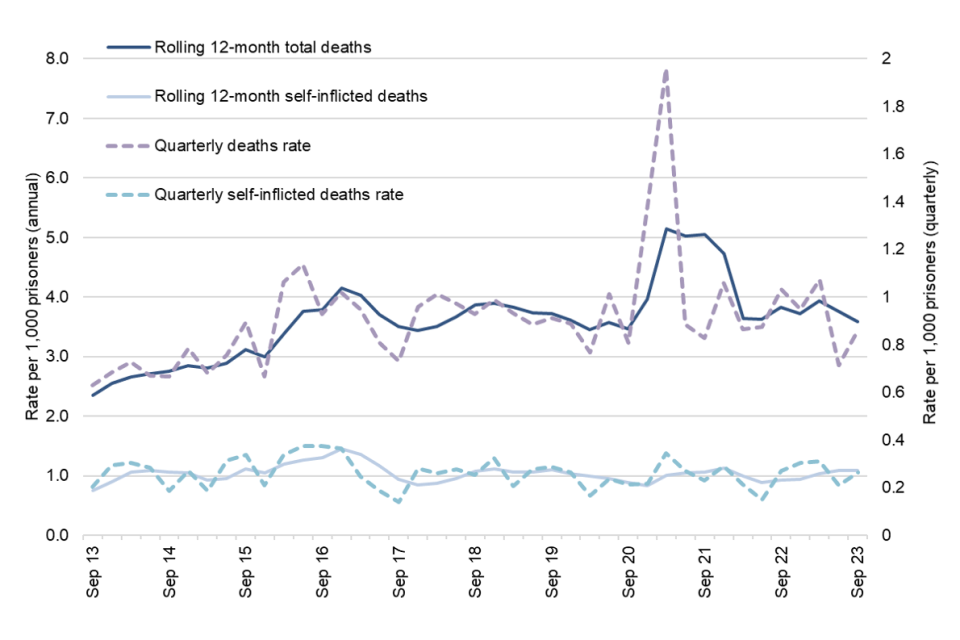
In the 12 months to September 2023, there were 304 deaths in prison custody (a rate of 3.6 per 1,000 prisoners), a decrease from 307 deaths in the previous 12 months (a rate of 3.8 per 1,000 prisoners). Long-term trends and more detail are presented in the annual tables[footnote 6].
Over the same period, there were 178 deaths due to natural causes (a rate of 2.1 per 1,000 prisoners), a 16% decrease from 211 deaths (a rate of 2.6 per 1,000 prisoners) in the previous 12 months.
There were 92 apparent self-inflicted deaths in the 12 months to September 2023 (a rate of 1.1 per 1,000 prisoners), an increase of 24% from 74 self-inflicted deaths in the previous 12 months (a rate of 0.9 per 1,000 prisoners). The rate of self-inflicted deaths has remained broadly stable at around 1 per 1,000 prisoners since the 12 months to September 2017.
There were 31 deaths recorded as ‘Other’ in the 12 months to September 2023, 25 of which are ‘awaiting further information’ prior to being classified. In some cases, the results of the toxicology and post-mortem tests are inconclusive, meaning classification cannot be arrived at until Coroner’s inquest takes place (which can be a considerable time after the death). As a result, the number and rate of deaths in the individual categories is not directly comparable with earlier years: it is likely that numbers in some categories will be revised upwards once classifications have been finalised.
In the most recent quarter there were 75 deaths, a 23% increase from 61 deaths in the previous quarter. There were 23 self-inflicted deaths in the latest quarter, a 28% increase from 18 in the previous quarter. However, quarterly death figures should be considered with caution due to greater volatility and the potential for seasonal effects.[footnote 7]
Self-harm: 12 months to June 2023
| The rate of self-harm incidents increased in both the male and female estate from the previous 12-month period | There were 64,348 self-harm incidents in the 12 months to June 2023, a 21% increase from the previous 12 months (an 8% increase in male establishments and a considerable 65% increase in female establishments). Over the same period the rate of self-harm incidents per 1,000 prisoners increased by 3% in male establishments and by 63% in female establishments. In the most recent quarter, there were 17,729 self-harm incidents, up 7% on the previous quarter (a 16% increase in male establishments but an 11% decrease in female establishments). |
| The number of individuals who self-harmed increased 7% in the latest year. | There were 11,760 individuals who self-harmed in the 12 months to June 2023, a 7% increase from 10,969 in the previous 12 months. The number of self-harm incidents per individual increased from 4.8 in the 12 months to June 2022 to 5.5 in the 12 months to June 2023. |
Statistics for the 12 months to March 2023 relate to the third full 12-month period since the start of the Covid-19 pandemic and the restricted regimes prisons put in place in order to safely manage the risks of infection during the pandemic, including an exit from the National Framework in May 2022, this affects the comparability of the statistics with previous years.
Figure 2: Quarterly 12-month rolling rate of self-harm incidents per 1,000 prisoners, 12 months ending June 2013 to 12 months ending June 2023, with quarterly rates
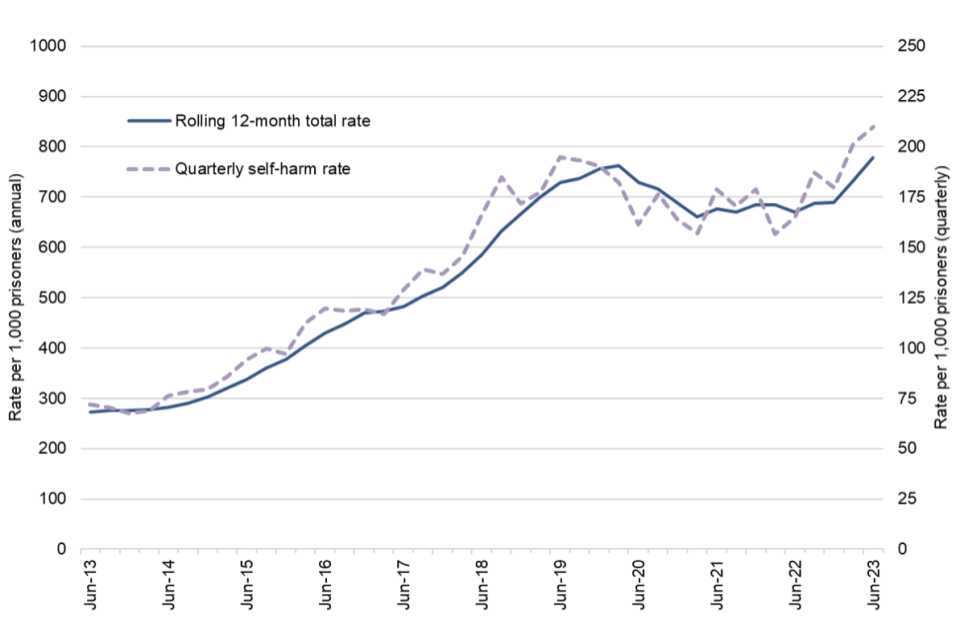
In the 12 months to June 2023, there were 64,348 reported incidents of self-harm (a rate of 778 per 1,000 prisoners), an increase of 21% from 53,021 in the previous 12 months. The rate of incidents in the latest 12 months increased 16% from the previous 12 months.
On a quarterly basis, the number of incidents in the three months to June 2023 increased by 7% from the previous quarter, from 16,541 to a new peak of 17,729 incidents. Additionally, the rate of incidents of self-harm in the three months to June 2023 increased by 4% from the previous quarter, from 201 to a new peak of 210 incidents per 1,000 prisoners.
The number of individuals who self-harmed increased by 7% to 11,760 in the latest 12 months (a rate of 142 individuals per 1,000 prisoners), from 10,969 in the previous 12 months. The rate, or proportion, of prisoners self-harming in the latest 12 months was 2% higher than in the previous 12 months. The number of incidents per self-harming individual in the latest 12 months reached a new peak of 5.5, an increase from 4.8 in the previous year. A small number of individuals who prolifically self-harm have a disproportionate impact on this figure: just over a half (51%) of prisoners who self-harmed in 2022 did so more than once.
The number of self-harm incidents requiring hospital attendance[footnote 8] increased by 10% to 2,950 in the 12 months to June 2023 and increased by 18% in the latest quarter to 870 incidents. The proportion of incidents that required hospital attendance has been on a downward trend from 7.1% in the 12 months to June 2016 to 4.6% of incidents in the latest 12 months.
Self-harm levels differ considerably by gender. Although the number of incidents in the female estate is smaller than in the male estate, the rate of self-harm per 1,000 prisoners is much higher. In the 12 months to June 2023, there were 44,100 incidents in the male estate compared with 20,248 in the female estate, representing an 8% increase in male establishments and a considerable 65% increase in female establishments compared to the previous year. However, the rate of self-harm in the female estate (6,213 incidents per 1,000 prisoners) was over eleven times higher than in the male estate (555 incidents per 1,000 prisoners), following a 3% increase in male establishments and a 63% increase in female establishments. The number of incidents and rate of self-harm in the female estate are now at the highest level in the time series[footnote 9].
The number of incidents per individual who self-harmed in female establishments was over four times that in male establishments. In the 12 months to June 2023 there was a new peak of 17.9 incidents of self-harm per self-harming female, a considerable increase from 11.5 in the previous 12 months, compared with 4.1 incidents per self-harming male, the same as in the previous 12 months.
The proportion of females self-harming in the latest 12 months was 5% higher than in the previous 12 months, at 347 individuals per 1,000 prisoners. The increase in self-harm in the female estate has been predominantly driven by the substantial increase in incidents per self-harming individual, alongside a smaller increase of 6% in the number of females self-harming. Over the same period, the proportion of prisoners self-harming in male establishments increased by 2%, to 134 individuals per 1,000 prisoners.
Figure 3: Quarterly 12-month rolling rate of self-harm incidents per 1,000 prisoners by gender of establishment, 12 months ending June 2013 to 12 months ending June 2023
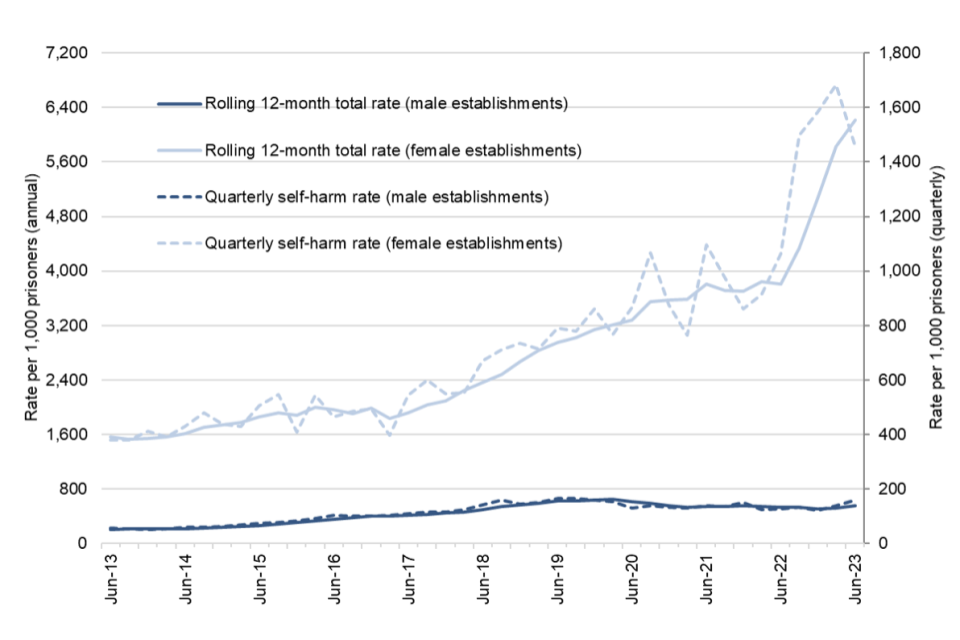
Self-harm incidents requiring hospital attendance increased in male establishments by 6%, to 2,607 in the 12 months to June 2023, but the proportion of incidents requiring hospital attendance decreased from 6.1% in the previous 12 months to 5.9% in the latest 12 months. In the female estate 343 self-harm incidents required hospital attendance, an increase from 220 incidents the previous year. However, the proportion of incidents in the female estate requiring hospital attendance was 1.7% in the 12 months to June 2023, down from 1.8% in the previous 12 months, reflecting that the considerable increase in self-harm incidents in the female estate has been predominantly in incidents not requiring hospital treatment.
On a quarterly basis, the number of incidents in the three months to June 2023 increased by 16% in male establishments and decreased 11% in female establishments compared with the previous three months. The number of incidents in female establishments decreased to 4,869 in the latest quarter after reaching a peak of 5,468 in the previous quarter. This is the first quarter-on-quarter decrease in the female estate since Q4 2021.
As Figure 3 shows, over the last decade there has been more variation in the quarterly rate of self-harm in the female estate than in the male estate. This may in part reflect the impact of the small number of individuals who engage in prolific self-harming being greater in the female estate. Fluctuations in the quarterly rates of self-harm in the female estate have been wider since the start of the pandemic, reaching a peak in the previous quarter.
Assaults: 12 months to June 2023
| Assaults and serious assaults increased from the previous 12-month period. | In the 12 months to June 2023, there were 23,557 assault incidents, a 15% increase from the previous 12 months. Of these, 2,704 were serious assaults, up 21%. Rates of assault and serious assault per 1,000 prisoners increased 9% to 285 and 16% to 33 respectively in the latest 12 months. Assaults increased 9% in the latest quarter to 6,560 incidents while the number of serious assaults increased by 18% to 769 incidents. |
| The rate of assault per 1,000 prisoners was higher in female than male establishments. | The rate of assault in male establishments increased by 9% from the previous 12 months, while the rate in female establishments increased by 21%. Assault rates for the 12 months to June 2023 remained higher in female establishments (469 incidents per 1,000 prisoners) than in male establishments (277 incidents per 1,000 prisoners). |
| Assaults on staff increased from the previous 12-month period. | There were 7,908 assaults on staff in the 12 months to June 2023, a 6% increase from the previous 12 months. In the latest quarter the number of assaults on staff increased by 13% to 2,222 incidents. In the latest 12 months, the rate of assaults on staff per 1,000 prisoners increased slightly, by 1% to 96 per 1,000 prisoners. During this period, the rate in male establishments remained similarly stable, however it increased by 11% to 223 per 1,000 prisoners in female establishments. |
Figure 4: Quarterly 12-month rolling rate of total assaults by gender of establishment, 12 months ending June 2013 to 12 months ending June 2023, with quarterly rates
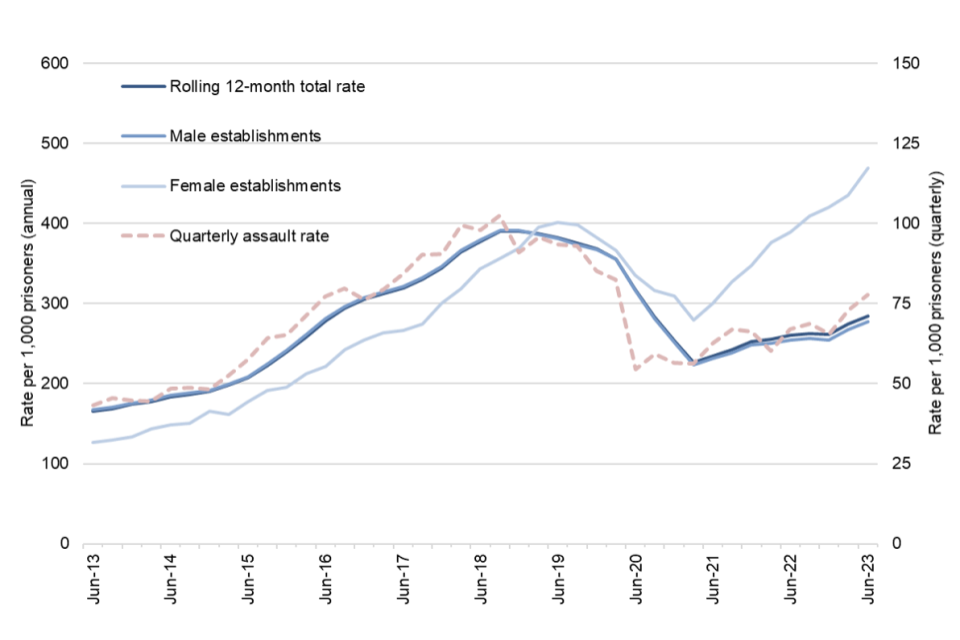
In the 12 months to June 2023, assault incidents increased by 15% to 23,557 (a rate of 285 incidents per 1,000 prisoners). The rate of assaults in the latest 12 months was 9% higher than in the previous 12 months.
In the latest quarter there were 6,560 assaults, up 9% from the previous quarter. The number of assaults and the quarterly rate remain lower than their peak in the July to September 2018 quarter. This reflects that quarterly numbers and rates of assaults were already falling before the outbreak of the Covid-19 pandemic as well as the considerable decrease in the early stages of the pandemic (April to June 2020) associated with changes in prison regimes and activity in the criminal justice system.
The number of incidents in male establishments increased by 14% from 19,310 to 22,027 in the 12 months to June 2023 (a rate of 277 per 1,000 prisoners). The rate of assaults in male establishments in the latest 12 months was 9% higher than in the previous 12 months.
The number of incidents in female establishments increased by 22% from 1,252 to 1,530 incidents in the 12 months to June 2023 (a rate of 469 per 1,000 prisoners). The rate of assaults in female establishments in the latest 12 months was 21% higher than in the previous 12 months, it is now at its highest level in the time series[footnote 10]. The rate in female establishments is now higher than it was pre-pandemic (469 compared to 402 in the 12 months to June 2019) while the rate in male establishments remains lower than pre-pandemic (277 compared to 384 in the 12 months to June 2019).
Assault rates have been higher in female establishments than in male establishments since the 12 months to June 2019, with the difference extending each year, after previously being higher in male establishments.
In the latest quarter, the number of assaults in male establishments increased 9% from 5,638 to 6,129, and the number of assaults in female establishments increased by 19% from 361 to 431. Additionally, in the latest quarter the rate of assaults increased by 6% to 78 assaults per 1,000 prisoners. The increase in quarterly rate was more substantial in female establishments (up 16% to 129 assaults per 1,000 prisoners) compared to male establishments (up 6% to 75 assaults per 1,000 prisoners).
Figure 5: Quarterly 12-month rolling rate of prisoner-on-prisoner assaults and assaults on staff, 12 months ending June 2013 to 12 months ending June 2023, with quarterly rates
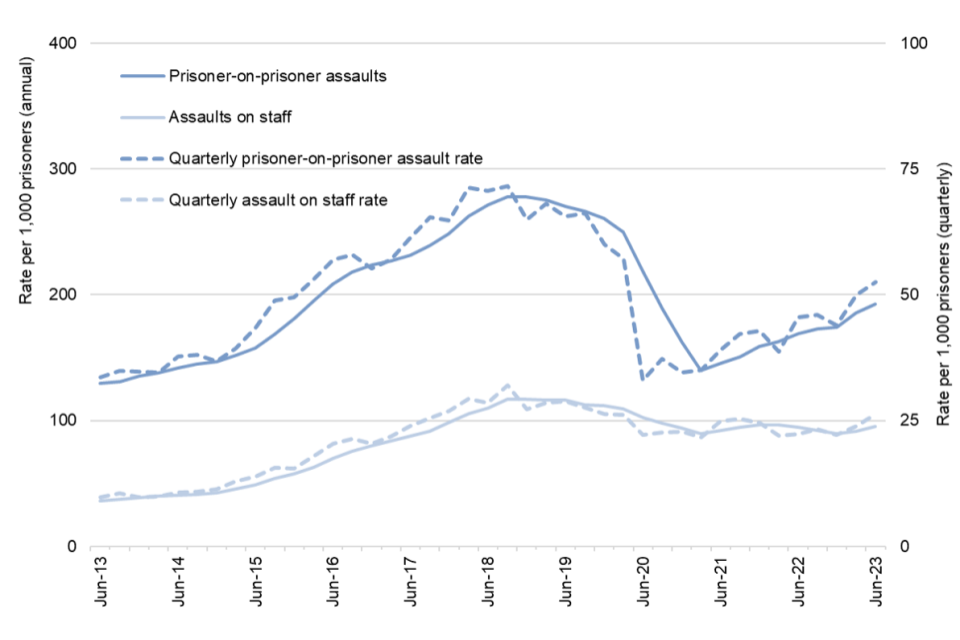
There were 15,918 prisoner-on-prisoner assaults[footnote 11] in the 12 months to June 2023 (a rate of 192 per 1,000 prisoners), an increase of 19% from the 13,385 assaults in the previous 12 months. The rate of prisoner-on-prisoner assaults in the latest 12 months was 14% higher than in the previous 12 months. In the latest quarter, there were 4,439 prisoner-on-prisoner assaults, an 8% increase from 4,108 in the previous quarter.
There were 7,908 assaults on staff[footnote 12] in the 12 months to June 2023 (a rate of 96 per 1,000 prisoners), an increase of 6% from the 7,457 assaults in the previous 12 months. The rate of assaults on staff in the latest 12 months was 1% higher than in the previous 12 months. In the latest quarter, there were 2,222 assaults on staff, a 13% increase from 1,959 incidents in the previous quarter.
The proportion of assaults on staff[footnote 13] decreased to 34% of all incidents in the 12 months to June 2023, from 36% in the previous 12 months, having previously steadily increased from 21% in the 12 months to June 2013 to a peak of 39% in the year to June 2021.
In male establishments, prisoner-on-prisoner assaults increased by 18% to 15,104 incidents (190 incidents per 1,000 male prisoners) in the 12 months to June 2023, and the rate increased 13%. Assaults on staff increased 5% to 7,181 incidents, with the rate remaining broadly stable (up 0.6%) at 90 incidents per 1,000 male prisoners.
In female establishments, prisoner-on-prisoner assaults increased by 33% to 814 incidents (250 incidents per 1,000 female prisoners) in the 12 months to June 2023, and the rate increased by 31%. Assaults on staff increased by 12% to 727 incidents (223 incidents per 1,000 female prisoners) in the 12 months to June 2023, and the rate increased by 11%. In the 12 months to June 2023, the rates of both prisoner-on-prisoners assaults and assaults on staff in female establishments reached a new peak.
In the 12 months to June 2023, the proportion of assaults that were on staff remained higher in female establishments (48%) than in male establishments (33%).
Serious assaults
| Of the 23,557 assault incidents, 2,704 (11%) were serious. | In the 12 months to June 2023, there were 2,704 serious assault incidents, a 21% increase from the previous 12 months. The rate of serious assaults increased by 16% over the period. Serious prisoner-on-prisoner assaults increased by 28% to 1,986, and serious assaults on staff increased by 4% to 748 in the 12 months to June 2023. |
Serious assaults are those which fall into one or more of the following categories: a sexual assault; requires detention in outside hospital as an in-patient; requires medical treatment for concussion or internal injuries; or incurs any of the following injuries: a fracture, scald or burn, stabbing, crushing, extensive or multiple bruising, black eye, broken nose, lost or broken tooth, cuts requiring suturing, bites, temporary or permanent blindness.
Figure 6: Quarterly 12-month rolling rate of total serious assaults, serious prisoner-on-prisoner assaults, and serious assaults on staff, 12 months ending June 2013 to 12 months ending June 2023
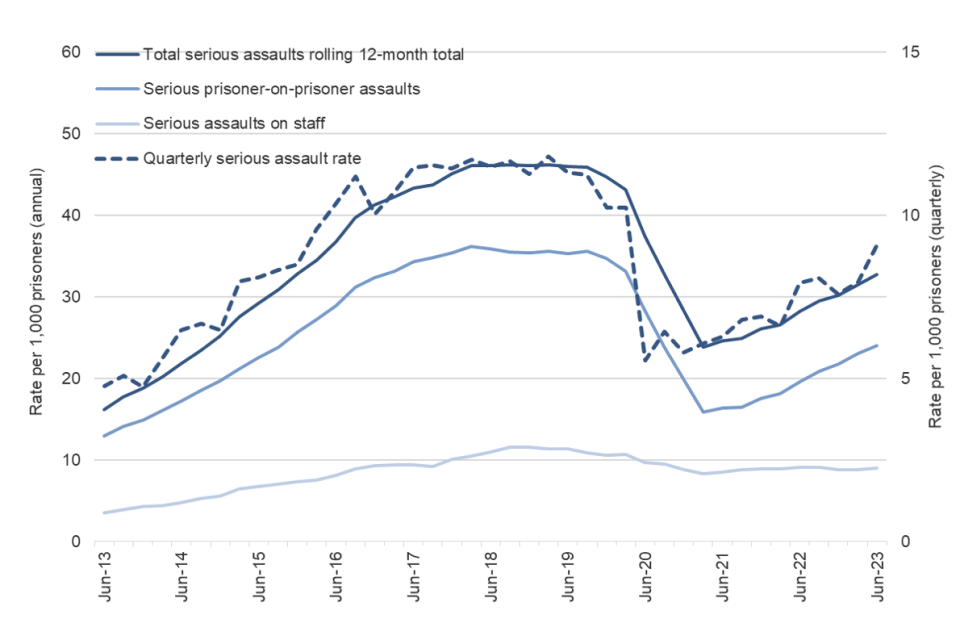
In the latest 12 months, 11% of assaults were serious assaults. This is the same as the 12 months to June 2022. The proportion of all assaults that were serious was higher in male establishments (12%) than in female establishments (6%).
In the 12 months to June 2023, there were 2,704 serious assaults (a rate of 33 per 1,000 prisoners), a 21% increase from the previous 12 months. The rate of serious assaults in the latest 12 months was 16% higher than in the previous 12 months. In the latest quarter, there were 769 serious assaults, an 18% increase from the previous quarter.
There were 1,986 serious prisoner-on-prisoner assaults (a rate of 24 per 1,000 prisoners) in the 12 months to June 2023, a 28% increase from the previous 12 months. The rate of serious prisoner-on-prisoner assaults in the latest 12 months was 23% higher than in the previous 12 months. In the latest quarter, there were 568 serious prisoner-on-prisoner assaults, a 17% increase from the previous quarter.
In the 12 months to June 2023, the rate of serious prisoner-on-prisoner assaults remains higher in the male estate (a rate of 24 per 1,000 prisoners) compared to the female estate (16 per 1,000 prisoners). This represents an increase on the previous 12 months of 22% in the male estate and 56% in the female estate.
There were 748 serious assaults on staff (a rate of 9 per 1,000 prisoners) in the 12 months to June 2023, a 4% increase from the previous 12 months. The rate of serious assaults on staff in the latest 12 months was broadly stable (0.7% lower) compared with the previous 12 months. In the latest quarter, the number of serious assaults on staff increased by 25% to 217 incidents.
Further information
National Statistics status
National Statistics are accredited official statistics[footnote 14] that meet the highest standards of trustworthiness, quality and public value.
All official statistics should comply with all aspects of the Code of Practice for Official Statistics. They are awarded National Statistics status following an assessment by the UK Statistics Authority’s (UKSA) regulatory arm. The UKSA considers whether the statistics meet the highest standards of Code compliance, including the value they add to public decisions and debate.
These accredited official statistics were independently reviewed by the Office for Statistics Regulation in March 2013. They comply with the standards of trustworthiness, quality and value in the Code of Practice for Statistics and should be labelled ‘accredited official statistics’.
It is the Ministry of Justice’s responsibility to maintain compliance with the standards expected for National Statistics. If we become concerned about whether these statistics are still meeting the appropriate standards, we will discuss any concerns with the UKSA promptly. National Statistics status can be removed at any point when the highest standards are not maintained, and reinstated when standards are restored.
Future publications
Our statisticians regularly review the content of publications. Development of new and improved statistical outputs is usually dependent on reallocating existing resources. As part of our continual review and prioritisation, we welcome user feedback on existing outputs including content, breadth, frequency and methodology. Please send any comments you have on this publication including suggestions for further developments or reductions in content.
Accompanying files
As well as this bulletin, the following products are published as part of this release:
-
A technical guide providing further information on how the data are collected and processed, as well as information on the revisions policy and legislation relevant to sentencing trends and background on the functioning of the criminal justice system.
-
A set of summary tables for the latest quarter, and annual tables up to the latest calendar year.
-
Underlying data files with pivot tables, giving lower level granularity.
Contact
Press enquiries should be directed to the Ministry of Justice press office: Tel: 020 3334 3536 Email: newsdesk@justice.gov.uk
Other enquiries about these statistics should be directed to:
Jon Mitchell
Data and Analysis,
Ministry of Justice,
102 Petty France,
London,
SW1H 9AJ
Email: OMSQ-SiC-publications@justice.gov.uk
Our statistical practice is regulated by the Office for Statistics Regulation (OSR). OSR sets the standards of trustworthiness, quality and value in the Code of Practice for Statistics that all producers of official statistics should adhere to. You are welcome to contact us directly, using the details above, with any comments about how we meet these standards. Alternatively, you can contact OSR by emailing regulation@statistics.gov.uk or via the OSR website.
Next update: January 2024 URL: https://www.gov.uk/government/collections/safety-in-custody-statistics
© Crown copyright
Produced by the Ministry of Justice.
Alternative formats are available on request from OMSQ-SiC-publications@justice.gov.uk
-
The time series for assault incidents starts in 2000, and self-harm incidents starts in 2004. ↩
-
Rates reflect the changes in the number of incidents, as well as the changes in prison population over time. More information can be found in the accompanying guide. Data on population statistics are published in the Offender Management Statistics Quarterly publication https://www.gov.uk/government/collections/offender-management-statistics-quarterly. ↩
-
Data on deaths is published three months ahead of self-harm and assaults. Therefore, the deaths annual publication and tables are published alongside the Safety in Custody quarterly update to September publication. ↩
-
https://www.gov.uk/government/collections/offender-management-statistics-quarterly. Quarterly population data to September 2023 is published in Offender Management Statistics Quarterly Bulletin, England and Wales Quarterly. ↩
-
The comparability over the year of other measures that are based on self-harming individuals (such as the number of incidents per self-harming individual, or the proportion of incidents requiring hospital attendance) are not affected by changes in population size. ↩
-
Data on deaths are published three months ahead of assaults and self-harm, therefore, the annual publication Deaths in prison custody for 1978 to 2022 is published in the Safety in Custody quarterly update to September 2022. ↩
-
Seasonal effects refer to variation in timeseries data that occur at regular intervals (typically intervals shorter than a year e.g. monthly or quarterly). ↩
-
An incident of self-harm requiring hospitalisation does not only reflect the seriousness of the incident. This also depends on the healthcare facilities at the establishment, which vary across the estate. ↩
-
The time series for assault incidents starts in 2000, and self-harm incidents starts in 2004. ↩
-
The time series for assault incidents starts in 2000, and self-harm incidents starts in 2004. ↩
-
This figure includes any prisoner-on-prisoner assaults where there may also have been an assault on staff. ↩
-
There was a change in how staff assaults have been recorded from April 2017, this has simplified how incidents involving staff are identified, however it is possible this has increased the recording of incidents. Please see the Guide to Safety in Custody statistics for further information. ↩
-
Some assault incidents may be recorded as both a prisoner-on-prisoner assault and an assault on staff, so the sum of the two categories may exceed the total number of assaults. ↩
-
Accredited official statistics are called National Statistics in the Statistics and Registration Service Act 2007. ↩
